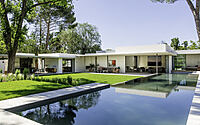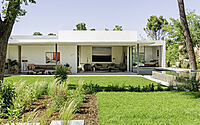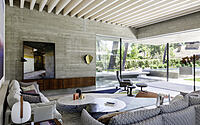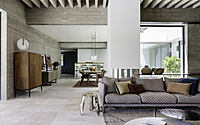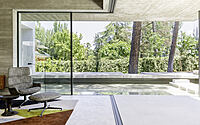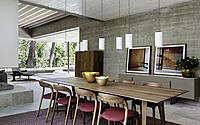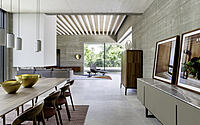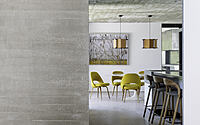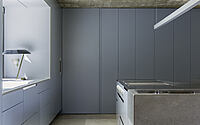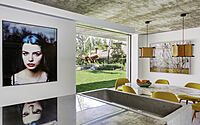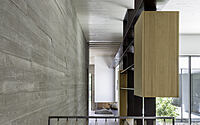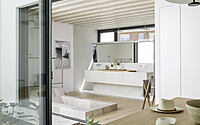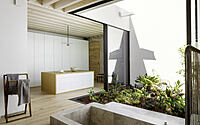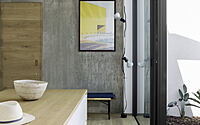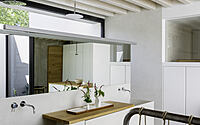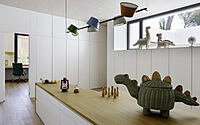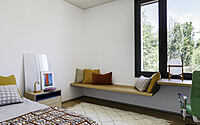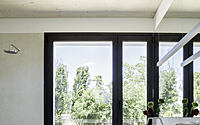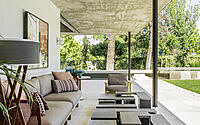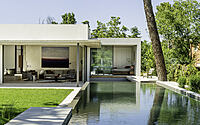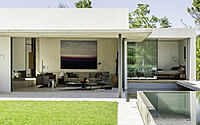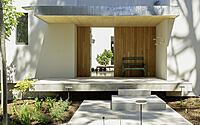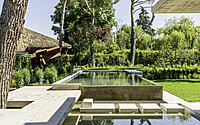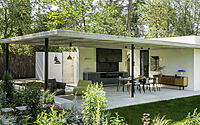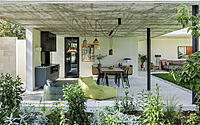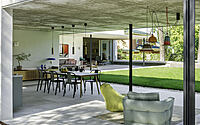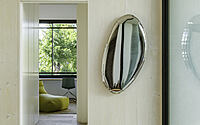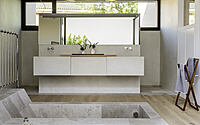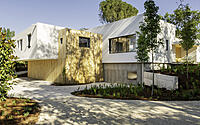Project AS by Ábaton Arquitectura
Project AS is a modern single-story house located in Madrid, Spain, designed in 2021 by Ábaton Arquitectura.






















Description
This detached single-family house of 700m2, with CLT wood structure, was designed for a family with small children who trusted ÁBATON for the project for the second time. In this case, the studio developed the interior design and landscaping projects, in addition to being in charge of the architecture and construction.
The existing slope of the plot, of approximately 3,000 m2, made it possible to create a two-story house, both in direct contact with the land. The first floor, with its north-facing garden and closest to the plot access, has its own entrance and houses the guest area, gym and other secondary uses, including the garage. The upper floor, linked to the larger garden area, groups all the family rooms. Bedrooms, living room, kitchen, projection room, porches… all the areas of this floor are intelligently located to facilitate the meeting and interaction of the family.
The entrance to the house is through a covered platform, which rises above the ground. This gives access to a hall in which the protagonist is a central courtyard, which functions as the core around which the common spaces revolve. This courtyard is glazed on four sides and visually connects all the surrounding spaces. It also allows light from the south to enter the northern part of the house and vice versa. It is designed to remain open during the temperate months of the year, thus replacing the circulation around the courtyard with paths through it. It also serves to ventilate the house during the night while the perimeter of the house remains closed, maintaining its security. Abaton designed the furnishing and decoration of this area so as not to obstruct the flow of the spaces connected by this central courtyard. In the same way it took into account the importance of the total coherence demanded by the visual connection caused by it.
On the south side of this courtyard is the dining room, connected to it by a large window that, due to its orientation and size, projects an indirect, intense and constant light on the dining area.
The fireplace, suspended from the roof, is open in all directions and separates the living and dining areas. Next to it is a built-in bench in front of a fixed glass, facing the courtyard to the west, through which the afternoon light enters. This light, together with the warmth of the fireplace, will make up one of the most enjoyable winter corners of the house.
Adjacent to the dining room is the living room, open to the east and south, where the main porch, garden and pool appear. The large sliding windows in this area were designed so that they could disappear completely behind the walls, giving this space, which is 3.6 m high, the feeling of a large open porch.
On the other side of the dining room is the kitchen. Although the circulation with the space to the east is open, visually this connection is minimal. With a ceiling height of only 2.5m, the feeling of intimacy is sought. At the back of the kitchen is the dining room, which opens to the garden through a window that, like others in the house, is completely hidden in the wall to transform the experience from indoor to outdoor space.The exposed concrete sheet on the kitchen ceiling projects southward defining the barbecue porch; this is the most open covered space in the house, with a panoramic view of the surrounding nature, linked to the kitchen, garden, pool and orchard.
To the north of the entrance, the central courtyard and the living room is the family area. The children’s room, to study or play, the cinema room, which overlooks the central courtyard in front of the dining room and the bedrooms and their adjoining areas. The cinema room receives light from the south through the courtyard and is connected to both the children’s room and the children’s common dressing room. The latter is part of the connecting discourse between the family members: The bedrooms do not have closets for clothes. They are all located in the dressing room, which connects the sleeping and bathrooms and thus becomes a place of meeting and interaction between them.
Access to the master bedroom is through the bathroom-dressing room, flooded with light from a second patio with more tropical vegetation than the first. Again, large windows that can be hidden make the bathroom and dressing room appropriate and enjoy an intimate outdoor space. The bathtub is recessed slightly, bringing it closer to the greenery of the courtyard. This was placed next to the west window to enjoy the afternoon sun in winter.
Once in the master bedroom, we see how it faces south, enjoying one of the most privileged views and at the same time private, thanks to its arrangement with respect to other areas of the house. A large sliding door opens onto a sheet of water overflowing the pool, located on a higher level.
In front of the porch, adjacent to the pool and at the request of the owners, a green meadow area was planned. The rest of the garden, still in an initial phase of growth, can be included in the new perennial landscape movement. With more than 50 species, it signifies, differentiates and accentuates the different spaces of the garden.
Photography by Belén Imaz
Visit Ábaton Arquitectura
- by Matt Watts